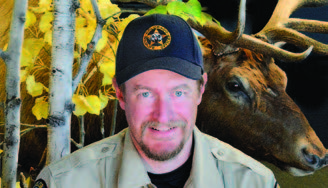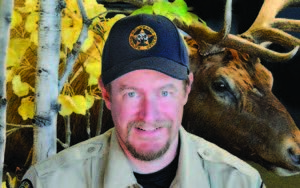Aaron Berscheid is a district wildlife officer for Colorado Parks and Wildlife. Aaron covers the “wild” side of Northeast El Paso County, including Black Forest, Falcon, Peyton and Calhan. He also covers some of Elbert County, north of U.S. Highway 24 and south of State Highway 86, including the towns of Elbert, Kiowa, Ramah, Simla, Matheson and a small portion of the Limon area.
Hug a hunter or angler to protect wildlife & habitat
By Aaron Berscheid
District Wildlife Manager, CPW
Sportspersons’ dollars support all of Colorado wildlife, including time-consuming, staff-intensive and expensive biological research and fieldwork needed to protect and restore endangered or threatened species like lynx, black-footed ferrets, raptors, greenback cutthroat trout, bighorn sheep and much more.
Hunting seasons are upon us and whether you hunt, or not, I want you to understand and even appreciate the importance of hunting in the conservation efforts of wildlife in Colorado.
For years, CPW ran ads urging people to: “Hug a Hunter” and “Hug an Angler.” It was a clever way to raise public awareness about why everyone should support hunting and angling, even if they don’t enjoy the sports.
As of 2022, CPW reported about 1 million fishing license holders and about 370,000 hunting license holders in Colorado. Those license sales generated $136 million in what we call “sportspersons’ dollars” that go directly into supporting our wildlife conservation efforts and protecting wildlife habitat.
Hunters and anglers also have a huge impact on the overall state economy. Each year, more than 1.4 million hunters and anglers contribute around $3.2 billion of combined economic benefit to the state and over 25,000 jobs.
Sportspersons’ dollars fund the vast majority of habitat improvement projects, public land purchases, herd management studies and native species restoration in Colorado.
Sportspersons’ dollars support all of Colorado wildlife, including time-consuming, staff-intensive and expensive biological research and fieldwork needed to protect and restore endangered or threatened species like lynx, black-footed ferrets, raptors, greenback cutthroat trout, bighorn sheep and much more.
Back in the Old Country, if residents of Europe wanted to hunt wildlife, they needed the permission of their king or queen because, in those days, the ruling monarchy owned the deer and wildlife of a nation. This made wildlife access limited to exclusive users and monopolized.
When our Founding Fathers were pulling together the United States some 250 years ago, it was socially unacceptable to have the government control the wildlife. Therefore, it was open season on wildlife. The public had few limitations on harvesting animals.
In fact, enterprising pioneers turned wildlife into a good source of income and “market hunting” appeared. People would go out and harvest as many animals as possible to sell at the market to make a living and feed their communities.
An obvious problem quickly developed: Market hunters harvested so many animals that wildlife populations began to drop. In fact, the situation became dire as many species were pushed to the point of extinction, if not made extinct entirely.
To conserve our wildlife populations, new styles of wildlife management were explored: preservation and conservation.
The creation of the National Parks system was an example of the preservation model. Huge swaths of land were set aside to not be touched; only to be observed. No one is allowed to hunt in these parks and all use of the area is what is called non-consumptive.
But preservation was too severe for the entire U.S., and states adopted the conservation approach to wildlife management. Conservation is the wise use of wildlife resources based on the belief that wild animals belong to all people, not just private landowners or just hunters.
The idea is that any consumptive use of wildlife populations needs to be regulated so that wildlife populations do not suffer, and so that future generations can continue to enjoy wildlife in perpetuity (ideally).
This is where hunters and anglers and CPW come into play. Yes, hunters and anglers are consumptive users of wildlife. And CPW uses them to maintain healthy wildlife populations by harvesting a specific number of each species annually.
Controlling wildlife populations is critical to ensure a balance of animals remain on the landscape and the habitat remains healthy enough to provide the grasses, nuts, berries, brush, trees and all to support and protect them.
We use hunters to control herd sizes. Without them, herds can grow far too large, leading to starvation and death. With a controlled and calculated amount of animals harvested each year, CPW can manage wildlife populations below a carrying capacity (the maximum number of animals that a habitat/landscape can support throughout a year).
How do we know exactly how to balance each species on specific landscapes? How do we know if plague, for example, is wiping out prairie dogs, causing a ripple effect among all the dozens of species that rely on them for food? How do we know about whirling disease in our waters or Chronic Wasting Disease in our soil infecting our ungulates?
We know because CPW employs an army of biologists who study these issues and then help us determine how to protect the animals.
All of that work is paid for with sportspersons dollars — not taxpayer dollars.
We also use revenue from federal taxes on firearms, ammo and fishing equipment sales to help with habitat and wildlife populations.
This is my long way of saying that even if you are not a hunter or angler yourself, or even if you do not agree with hunting, at least you know that there is a very strong benefit to wildlife derived from the wise and conservative consumptive use of wildlife.
In the coming months, I’ll share more stories as I write about wildlife issues in our community: Got a question, problem or column idea, please email me at aaron.berscheid@state.co.us or call me at 719-227-5231.
I might even answer your question in a future installment of “Wildlife Matters.”





